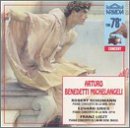| All Artists: Schumann, Grieg, Liszt, Michelangeli Title: Piano Concertos (Scala Di Milano 1939-1942) Members Wishing: 0 Total Copies: 0 Label: Arkadia: the 78's Original Release Date: 1/1/1939 Re-Release Date: 7/25/2000 Album Type: Import Genre: Classical Styles: Chamber Music, Forms & Genres, Concertos, Historical Periods, Classical (c.1770-1830), Instruments, Keyboard Number of Discs: 1 SwapaCD Credits: 1 UPCs: 675754243425, 8011571785724 |
Search - Schumann, Grieg, Liszt :: Piano Concertos (Scala Di Milano 1939-1942)
 | Schumann, Grieg, Liszt Piano Concertos (Scala Di Milano 1939-1942) Genre: Classical
|
Larger Image |
CD Details |
CD ReviewsWRONG LISZT, RIGHT LISZT DAVID BRYSON | Glossop Derbyshire England | 06/25/2004 (4 out of 5 stars) "The Liszt concerto here is the first and not the second, for the benefit of anyone else who is trying to obtain this disc in the hope of finding the latter. I'm not now aware of any recording by Michelangeli of the second concerto. So far as I can tell, this performance of the first is the one that helped him win the Geneva competition at age 19 and elicited the exclamation from Cortot `A new Liszt is born'.The Liszt performance is from 1939, and is perhaps slightly better recorded than the Schumann and Grieg, both dating from 1942. I own later performances of all three works by him. The later Liszt account, from his infamous Japanese tour, is preferable to this by virtue of recorded quality, the later Grieg and Schumann seem to me better as performances also. This is, I should say, strictly a record for Michelangeli-collectors. He was a notorious maverick - moody, unreliable and elusive - and his public repertory, when he deigned to put in an appearance at all, was very small. For me, the fascination in tracking his development is not just in his monumental greatness but also in his unpredictability. In some works, e.g. this Liszt concerto, he changed his interpretation very little, in others like the Schumann he changed it slightly, and in others like the Grieg he changed it spectacularly. From what I hear on this record, he seems to have been in a rather demure phase in 1942. The last movement of the Schumann is a very restrained `allegro vivace', and the first movement is downright slow. I adore Lipatti's high-velocity readings of both movements, but they don't have to be done that way and if I had to name my outright favourite performances of both the Schumann and the Grieg I would still unhesitatingly plump for Cherkassky whose speeds in the outer movements are quite moderate. What M seems to do here in the Schumann is loiter. Apart from an astonishingly leisurely first movement, he drops down a gear at the second subject of the finale. Some retardation at this point is perfectly reasonable, and Backhaus for one carries off the trick very successfully, but there are limits surely. In the Grieg and the Liszt it's easier to form a clear view of the performances. This Grieg is rather like a lower-voltage version of the extraordinary account that he recorded later with the New Philharmonia under Fruehbeck de Burgos. The phrasing is quite similar, in particular a gorgeous suggestion of birdsong in the slow movement that he plays up spectacularly in the later version. The tempi of the outer movements in this performance are a bit slower, but the real difference is in the `charge'. His later version is the most vivid and electric I think I have ever heard from anyone, and I wonder whether the photograph of him dripping with perspiration on the leaflet with that BBC record was taken at the conclusion of the performance, as I suspect it probably was. In the Liszt he may have decided that he had a winning formula that he didn't want to change, and if so I would back his decision. I own other performances of it by Richter, Cziffra and Ogdon, all on top form, but Michelangeli has them licked. The recording here doesn't do justice to that amazing finger-power, and the quality on the Japanese performance is nothing outstanding either, but through owning it I'm able to appreciate what his audience in 1939 must have heard and wondered at.The photograph in profile of the youngster is recognisable as the man we came to know, mainly on account of that great Roman nose like the prow of a ship. The playing is not altogether so recognisable because the recorded quality is not quite good enough to convey his unique tone-quality, the quality that more than anything else made M unique. I'm prepared to give the record 4 stars despite the recording, but I need to make it clear that I'm talking to M's other devotees and votaries when I do so. Not a safe recommendation to music-lovers in general, but a priceless document to some of us."
|

 Track Listings (10) - Disc #1
Track Listings (10) - Disc #1